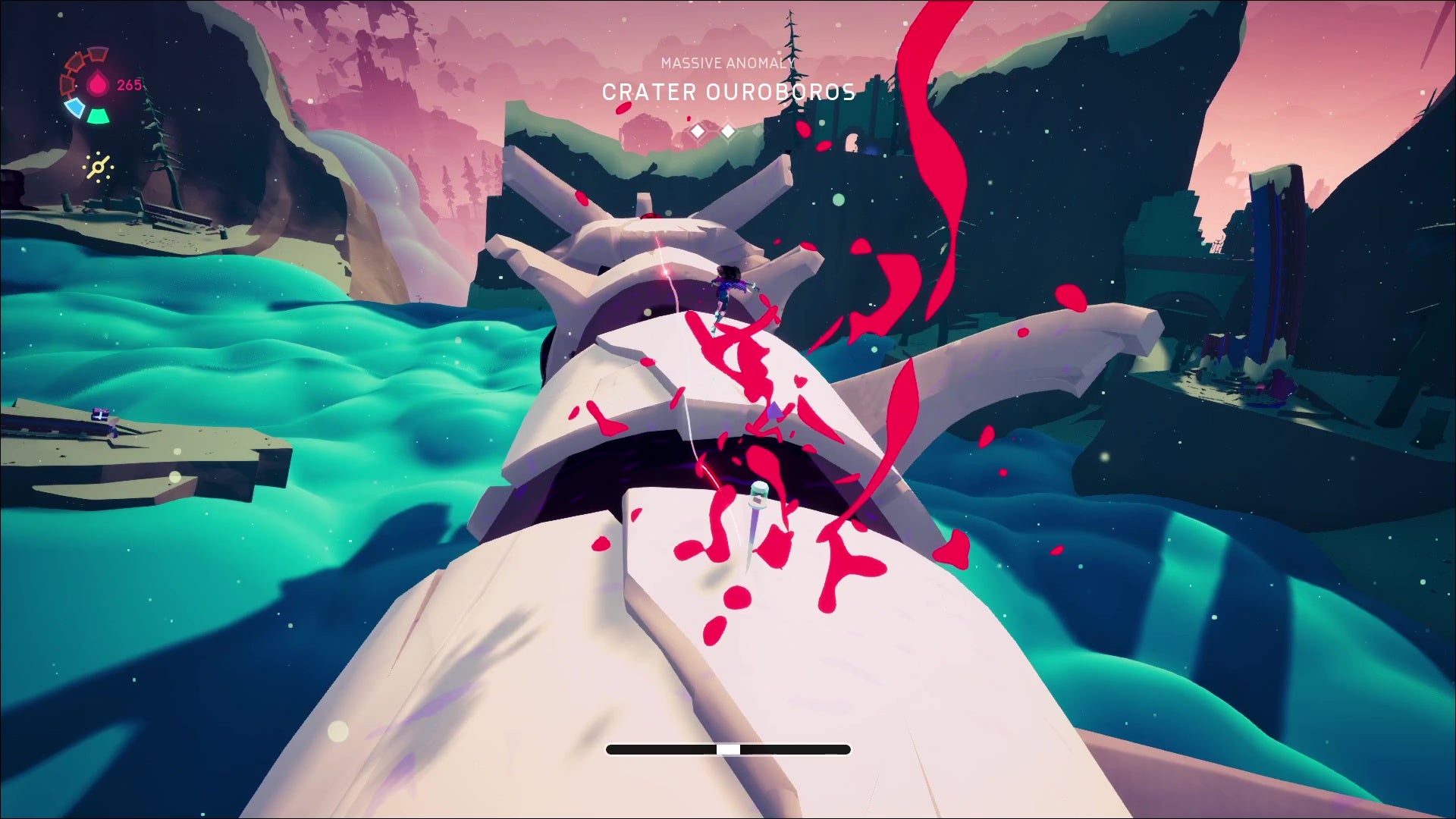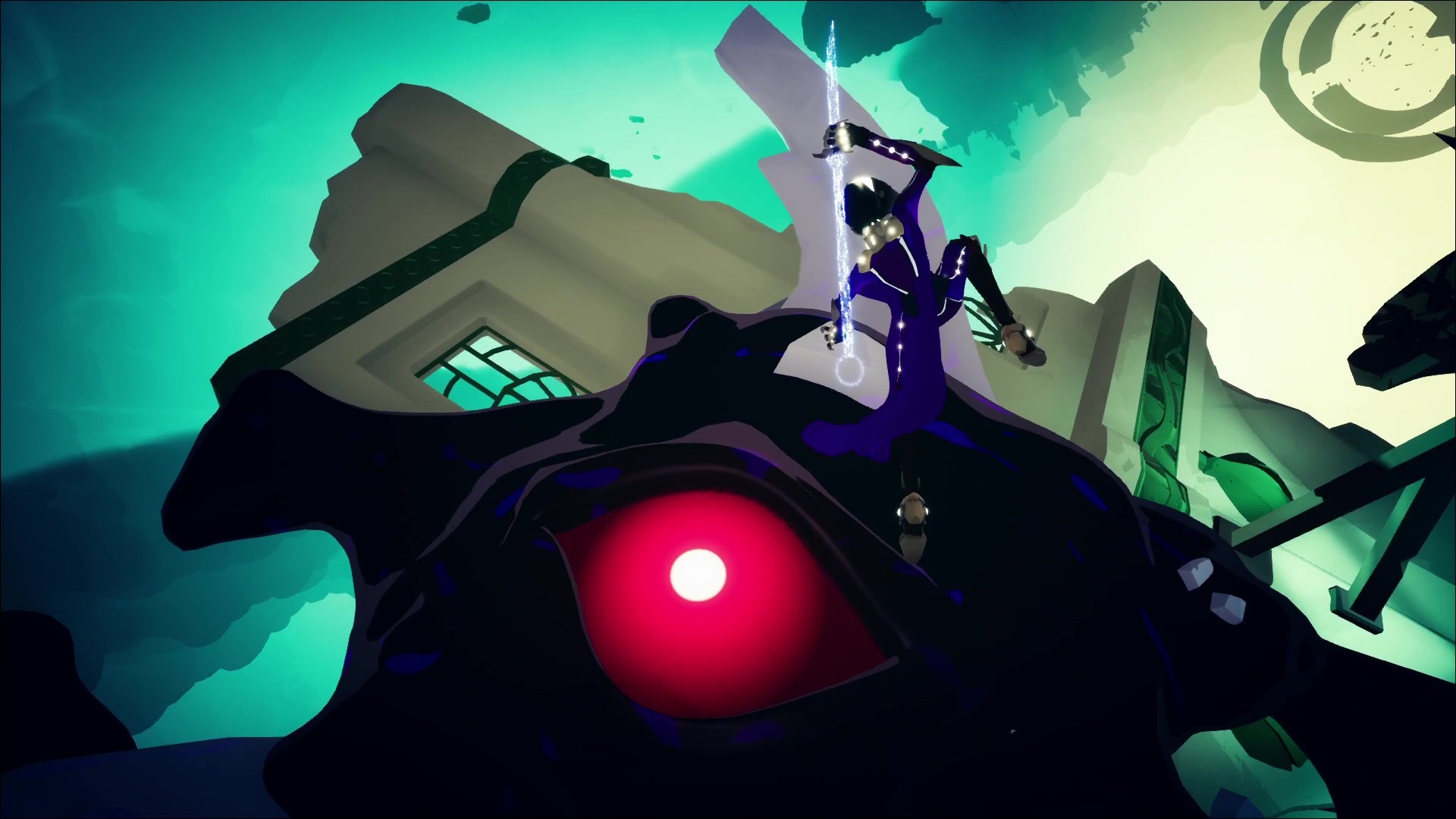In Solar Ash, you play as space-skater Rei whose planet is being sucked into a massive black hole called the Ultra Void. Normally, you’d twist a knob on this big tower called the Starseed and hey presto, you’d rescue the planet from Suction Destruction. But for some reason, the Starseed is no longer operational and the Ultra Void seems particularly sucky this time. Something’s gone wrong. So, it’s up to you to venture into the Ultra Void and see what’s cracking. Turns out the Ultra Void isn’t “cracking” but “clogging”. Towering monsters called Remnants have left this dark gloop splattered across the land and it’s up to you to clear out this corruption. How? By taking that blade of yours and poking their eyes out. Thing is, when you do go a-prodding, you don’t feel too good about it. It does that Shadow Of The Colossus thing where downing these creatures doesn’t inspire jubilant celebration, but more of a guilty “Sorry, big fella”. While it’s nothing new, I liked how there’s a thick layer of unease underpinning everything you do. Still, you march on. And over the course of around five to six hours, you’ll travel to a handful of increasingly complex areas and clear them of Remnants whether you like it or not. By doing so, your hope is to reactivate the Starseed and do away with the Ultra Dyson forever. This isn’t structured like an open-world game, though. You can’t tackle any Remnant you’d like from the outset. Instead, you’ll need to beat one before you can unlock the next. It’s not just a case of hopping on the back of these Remnants, Shadow Of The Colossus-style, either. Each area has a few corrupted spots which you can ping on your HUD with your scanner. Only once you’ve cleared these out does their resident boss spring to life. That’s the rhythm of Solar Ash: scan each area for corrupted bits, clear corrupted bits to awaken the boss, defeat said boss, move onto another area, repeat. It’s a rigid structure that does more harm than good. The game barely deviates from this loop, which keeps things digestible, but ultimately becomes a bit samey. Sure, interspersed throughout these areas are little side stories and collectible audio logs, yet they all boil down to finding or activating three, four or five things. Let’s just say that by the end credits, I’d had my fill. The real star of this game is the movement, which has you rollerblade around shattered worlds like a post apocalyptic gazelle on wheels. I used a controller as it felt far more intuitive than mouse and keyboard. Squeeze the left trigger and you’ll transition from a gentle jog to a wonderful glide that picks up momentum as you stride forwards. Give the right trigger a pull and you’ll get this brief nitrous boost that’ll let you ramp off terrain with extra gusto. Easily my favourite is the grappling hook, because we love a grapple don’t we? Slap the right bumper and you’ll slingshot to floating rings with a delightful snap. Solar Ash gets one thing so ridiculously right, and that’s feeling cool as heck when skating around its gorgeous environments. They’re all designed with your rollerblades in mind too, with honking great drops that springboard you onto ruined skyscrapers. You’ll flip between cracked slabs like a supersonic trampolinist. You’ll grind on rails and tumble into dark chasms. Despite succumbing to a black hole and big monsters, the world does makes for a brilliant skate park. It makes the pursuit of those scanned lumps of Remnant muck a real treat. Not only does it feel great catapulting yourself over to each one, but it’s also the act of viewing the landscape and piecing together the correct route which adds an extra layer of enjoyment. They’re just difficult enough to present a challenge, but never leave you stuck for long, which I appreciated. Over time, the game introduces new ways to traverse the world and reach those pesky bits of Remnant soup. It starts off easy with rails you can grind, but then it gets a bit more complex. To give one example, you’ll eventually come across different coloured mushrooms that release certain scents that cling to you for a short time when hit. You must then whizz over to a corresponding mushroom of the same colour to activate it, which should then open a door or the like. Later: MORE mushrooms with different properties. They’re dropped in at a manageable pace and together they make for some sweet skating times. However, some worlds become so fixated on them that they wear you down. Occasionally, I just wanted to break free of their restraints and blast through some clouds for a bit. Taking on all that Remnant goop is a great way to flex your knowledge, though. They’re essentially time-attacks, where you’ve got to slice and stab your way through environmental puzzles before the timer expires. Maintaining your momentum is key here, as you need to slice through each checkpoint to reset your timer and stay alive, and there’s a real elegance to its overall design. They’re also a fun way of measuring how far your skating skills have come, too, and I never lost that buzz of nailing one on the first try. This sense of energetic expectation is ramped up even further when you finally take on an area’s resident Remnant boss. First off, they’re colossal creatures that roam the lands in spectacular fashion. Bone serpents, giant titans, a gangly sphere that’s the size of a flipping planet. To take one down, you’ll need to find a spot on their body you can grapple onto. Once that’s done, it’s back to slicing and grappling through checkpoints, only this time you’re skidding around on the back of a beast. Move over Shadow Of The Colossus, with your slow, clumpy movements. How dull. We’ve got Solar Ash over here, doing flips and shit. The music swells, the checkpoints burst… You’ve never concentrated so hard in your life. And then squelch, that’s one weak spot down. Another two to go. But the real fight is only just beginning. You see, each Remnant has three phases, and with every blow sheds more of its armour. This means you’ve got less and less safe ground to work with. The checkpoints become wider, the route windier, and the floor, lava. Even when you muck things up, though, Solar Ash never really gets that frustrating. You might lose one of Rei’s armour cores, but you can just replenish this by smashing a nearby box. It also only takes a few seconds to climb back up and have another swing at things. It’s all lovely stuff, but I wish Solar Ash had more of these moments outside of its boss runs. There are glimpses, sure, but it’s so stubborn in its structure it almost verges on restricting the flow of its own movement. You know you’re only going to ride the organic express a handful of times. Otherwise, it’s a lot of stopping and starting as you figure out the next fungi-puzzle. Perhaps I’m being a bit harsh here, but that’s because Solar Ash’s movement is brilliant and I hunger for more ways to roam its wastes. Don’t expect one fluid joy ride, but when it does come together it really does impress. If you’re after a few hours of slicin’ and skatin’, I’d say it’s worth strapping those blades up.



